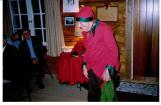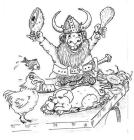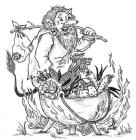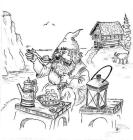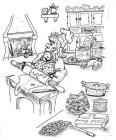2
Trolls - Characteristics of trolls as outlined in Scandanavian folklorehistorical and present day
Norway
All About NorwegianTrolls!
Common Characteristics of Trolls:
Other Interesting Facts About Trolls:
Credits:
Scandinavian Gnomes and Trolls Coloring Book, Bev Barbo, Carlsons' 1983
Brit Langkaas; Heidi Lervold; Ingrid Salensminde; Oivind Madssen - contributed interesting facts about trolls
3
Norwegian Trolls - Statues20th Century
Red Deer, Alberta, Canada
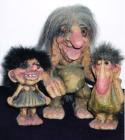 Credits:
Credits:Norwegian Laft Hus Society
4
Artifacts at Laft Hus - Troll Statue donated by Eileen ScheitzschRed Deer, Alberta, Canada
 Credits:
Credits:Norwegian Laft Hus Society
5
Gnomes - Characteristics of gnomes in Scandanavian traditional folkloreGnomes
Scandinavian Gnomes and Trolls Coloring Book, Bev Barbo, Carlsons' 1983 copyright
6
Nisse Figures Made by Laft Hus Society Members, For Sale?
Red Deer, Alberta, Canada
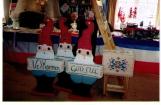 Credits:
Credits:Norwegian Laft Hus Society
8
Nisse - Who are these creatures?2007
Norway
Who/What are Nisse?
A "Nisse" is the name for a small humanlike creature who resembles "Santa Claus" in appearance (and in recent years, takes on the similarity of the modern American Santa Claus). He is not exactly an elf nor a dwarf, but something in between. Nisser can be gnome, ghost or shadow. Nisser are cute little creatures who, according to the Norwegian folklore, are often seen wearing a red knitted cap, usually red, and short grey or brown trousers (like bunad trousers), a knit sweater or busserull and with a long beard. He is the best known creature in Norwegian folklore. Even today, some people believe that he exists.
From Norwegian rural areas there are lots of legends about Nisse's life and duties. The farmers believe that having a Nisse living in their barns will bring them luck and good harvests. If they are so lucky to have a Nisse present, they prepare food for him, especially at Christmas time, and place this in the barns. The food is always eaten up by the next morning! If the farmers take good care of their "personal" Nisse, he will jump in the moving carriage to continue living with the farmer should a farmer purchase a new farm.
The word Nisse is not originally a Norwegian word.Originally nisse was "Fjosnissen" who was a little fellow living somewhere inthe barn with the cows (fjos). The farm Nisse is kind and helpful. He takes care of people and animals all year round. It is very important to be on good terms with the farm Nisse, otherwise strange incidents can occur on the farm. It is wise to remember the Nisse during Christmas and to put a bowl of porridge for him and his family. There is even a Norwegian Christmas song about the rats that are trying to steal his Christmas porridge called "Pa laven sitter Nissen med sin Julegrot" (In the barn the Nisse is sitting with his Christmas porridge).
The Jule-Nisse (Christmas Nisse) is said to come out of the mountains for a twelve-day period during the Christmas season. He will come to a certain farm at that time. If he is treated kindly by the people on the farm, he will remain there for that full-time and then disappear as suddenly as he arrived. The Jule-Nisse sems to love all the animals and is said that he has the power to bring good luck to people and good health to the animals, unless he is treated badly by his "hosts".
If lucky you can see Nisse all year round.
Credits:
Thor and Joan Dahl, www.trollshop.net
Norwegian Laft Hus Society
Ingrid Salensminde; Brit Langkaas; Heidi Lervold; Oivind Madssen - contributed facts about Nisse
9
Julenisse Velkommen sign1990's
Red Deer, Alberta, Canada
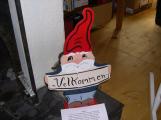 Credits:
Credits:Nisse Elf Sign made by Julie Macrae

